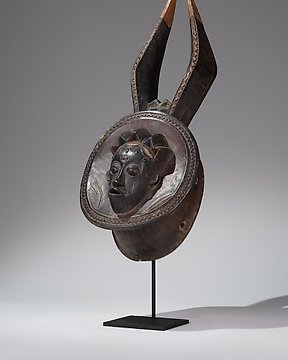
Baule - Elfenbeinküste (Ohne Mindestpreis)
Nr. 83439615

Nr. 83439615

A male Baule monkey sculpture, Ivory Coast, Central Baule region, collected in the village village Dimbokro, the legs in a bent position, large genitals, tubular torso, square shoulder, arms stuck to the torso, hands close to the navel, the short, thick neck carries a conical head with protruding jaw/ wide half opened mouth, long nose, framed by two circular, hollowed eyes; the face is encrusted with remnants of small reddish seeds, some age cracks, the feet and right arm have suffered by some insect damages, signs of ritual use. Certificate of provenance.
"Baule Monkeys are powerful objects, which are forbidden to be seen in public display. Monkey figures share stylistic features with the mens´s sacred masks, and have some of the qualities of secrecy and danger to women. They combine animal and human traits in such way that it is nearly impossible to separate them, and they have the prominent teeth and boxy muzzle typical of the masks. Both also receive sacrifical offerings directly on the sculpture, and are associated with the bush. Mbra monkey figures, for example are kept in the village, but "fed" with sacrifices in the bush."
Susan Vogel, 1997:238
"In Baule culture, cupbearing monkey statues, commonly known as "gbekre" since their first mention in 1900 by Maurice Delafosse, belong to the category of amwin, or "objects of power". They were used by men-only initiation societies for a number of purposes, both functional – as a basis for prophylactic practices, linked to agrarian rites or to a form of divination known as mbra (Bouloré in RMN, 2000: 107 et Vogel, 1997: 221-230) – and iconographic, each type being designated by a specific term (aboya, mbotumbo, ndyadan, gbekre...)."
Source: Sotheby's
Claessens, B., Baule Monkeys, 2016, without any doubts the best book about this topic.
So kaufen Sie auf Catawiki
1. Etwas Besonderes entdecken
2. Höchstgebot abgeben
3. Sichere Zahlung durchführen